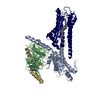+Search query
-Structure paper
| Title | Lipid-Dependent Activation of the Orphan G Protein-Coupled Receptor, GPR3. |
|---|---|
| Journal, issue, pages | Biochemistry, Vol. 63, Issue 5, Page 625-631, Year 2024 |
| Publish date | Mar 5, 2024 |
 Authors Authors | Isabella C Russell / Xin Zhang / Fabian Bumbak / Samantha M McNeill / Tracy M Josephs / Michael G Leeming / George Christopoulos / Hariprasad Venugopal / Maria M Flocco / Patrick M Sexton / Denise Wootten / Matthew J Belousoff /   |
| PubMed Abstract | The class A orphan G protein-coupled receptor (GPCR), GPR3, has been implicated in a variety of conditions, including Alzheimer's and premature ovarian failure. GPR3 constitutively couples with Gαs, ...The class A orphan G protein-coupled receptor (GPCR), GPR3, has been implicated in a variety of conditions, including Alzheimer's and premature ovarian failure. GPR3 constitutively couples with Gαs, resulting in the production of cAMP in cells. While tool compounds and several putative endogenous ligands have emerged for the receptor, its endogenous ligand, if it exists, remains a mystery. As novel potential drug targets, the structures of orphan GPCRs have been of increasing interest, revealing distinct modes of activation, including autoactivation, presence of constitutively activating mutations, or via cryptic ligands. Here, we present a cryo-electron microscopy (cryo-EM) structure of the orphan GPCR, GPR3 in complex with DNGαs and Gβγ. The structure revealed clear density for a lipid-like ligand that bound within an extended hydrophobic groove, suggesting that the observed "constitutive activity" was likely due to activation via a lipid that may be ubiquitously present. Analysis of conformational variance within the cryo-EM data set revealed twisting motions of the GPR3 transmembrane helices that appeared coordinated with changes in the lipid-like density. We propose a mechanism for the binding of a lipid to its putative orthosteric binding pocket linked to the GPR3 dynamics. |
 External links External links |  Biochemistry / Biochemistry /  PubMed:38376112 / PubMed:38376112 /  PubMed Central PubMed Central |
| Methods | EM (single particle) |
| Resolution | 3.49 Å |
| Structure data | EMDB-42023, PDB-8u8f: |
| Chemicals |  ChemComp-PLM: |
| Source |
|
 Keywords Keywords |  MEMBRANE PROTEIN / GPR3 / orphan GPCR / MEMBRANE PROTEIN / GPR3 / orphan GPCR /  GPCR GPCR |
 Movie
Movie Controller
Controller Structure viewers
Structure viewers About Yorodumi Papers
About Yorodumi Papers






